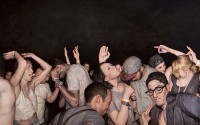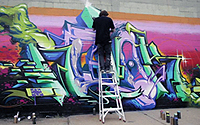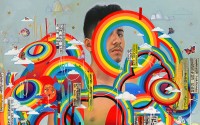![]()
Writhing, Sweaty, and Ecstatic: The Realist Paintings of Dan Witz
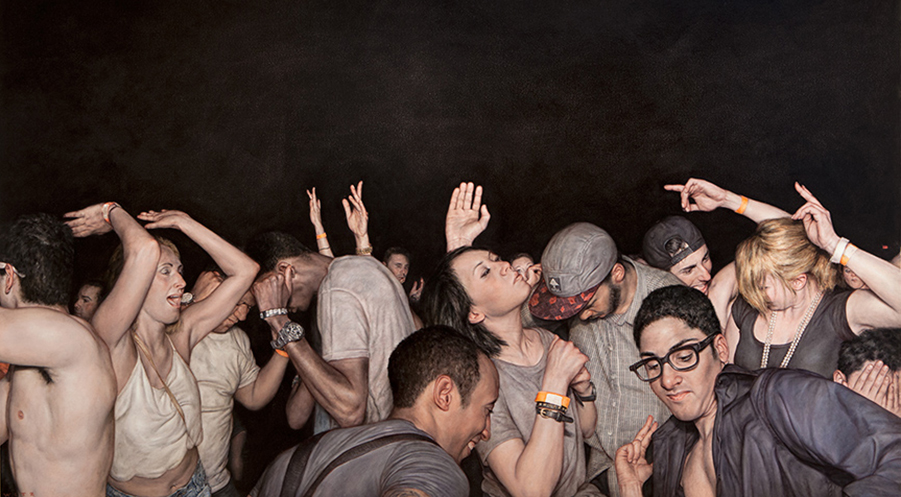
Sweaty, writhing bodies caught in the heat of the moment: Dan Witz is a voyeur. His academic paintings of mosh pits, and now raves and orgies, capture people at their most intense, ecstatic, and animalistic. While his previous subject matter has included mainly subjects he shot in the mosh pits of hardcore shows, his latest series, Mosh Pits, Raves, and One Small Orgy expands his oeuvre to include different settings, but similar groups of strangers gettin’ down in various ways.
To find out more about his process and his relationship to mosh pits and painting, The Creators Project talked to Witz in advance of his show, which opens April 2 at Jonathan LeVine Gallery. On the way, we also stopped on topics like ditching your tour mates to visit art museums, Donald Trump rallies, and Walt Whitman.
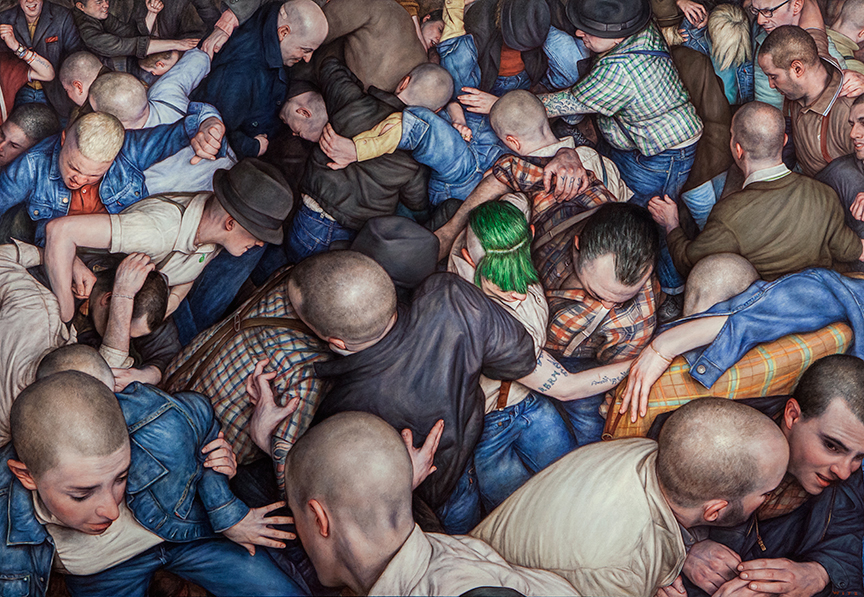
Byronesque 3
The Creators Project: First off, can you tell me about the origins of your Mosh Pits paintings?
Dan Witz: I’m a little reluctant to admit this, but the greatest single influence on my painting hasn’t been any fancy art-smart aesthetic theory. It comes from the music I’ve grown up with. The artists I most admire have almost always been musicians, and most of my best ideas come from the transgressive energy of rock’n’roll.
In my early 20s I played in post punk New York noise bands. I was never much of a musician but it was a lot of fun, and as important a part of my education as art school. While on tour in Europe, during the day, I’d sneak out and visit art museums. I’d usually be sleep deprived and hungover, a raw, exposed nerve from my nightly escapades over-romancing the punk lifestyle, but in that dilated condition the bizarre sense of space and presence in those old master paintings completely cracked me open—I mean it left me totally dumbstruck. It took awhile to process those two worlds colliding, but eventually it occurred to me to paint hardcore shows in an academic realist style.
Can you walk us through your process, from show, to studio, to show?
The whole thing starts long before the actual putting of brush to canvas. It all begins at the right kind of hardcore show (crowded, unregulated), where I photograph the mosh pit for source material. The painting lives or dies on the level of chaos and abandon I find at the concert—and my ability to get in there and capture it. That’s why I prefer old school bands like Agnostic Front or Vision of Disorder—the audience really lets themselves go for those guys.
After I start photographing I slip into the moment and improbable amounts of time passes without me. Which is something I dearly love—a state of flow similar I imagine to what athletes describe. Drained and sometimes a bit bruised, I drag myself home and hole up with Photoshop, which is another lovely lost world for me.
Puzzling together the compositions can take months. Each grouping is made up of separate photos, which requires a lot of fiddling and minute adjustments if it’s going to look natural. Then comes the long hard slog of the actual painting, a gestational feat which, to be honest, is frustrating and difficult but never becomes routine.
Somewhere in my youth I had the misfortune of picking up the cliché that great art involves suffering. It’s hard for me to accept that I’ve consciously set myself out to suffer, but this process, although very rewarding, seems to qualify as that.
These shows can last for several hours—how do you choose which moments you want to depict?
After photographing in the mosh pits for a while the musician in me began to get familiar with patterns in the songs. Eventually it got to the point where I could sense the moment coming when the crescendo is building and the crowd will go totally berserk. I keep the camera on a pole so I count down with the bass player and lift the camera over the eye of the pit hoping the shutter will click at the optimum moment. It’s mostly luck but when I nail one it’s as satisfying as performing.

Sick of It All
Your work shows a definitive Baroque influence, both naturalistic and theatrical. Do you see a connection between the violent imagery of Baroque paintings and the contained aggression of the pit?
While I’ve looked long and hard at the baroque artists, and use a lot of their methods, I‘m actually not a huge fan of their work (except for Caravaggio and some of his followers). The other day I was admiring some photos of those spiky, obstreperous wild-style graffiti murals, and thinking that those are an excellent visual corollary to the experience of a hardcore concert (and that contained aggression you’re referring to). Rubens and all those theatrical Baroque painters were chiefly concerned with their narrative, always circling back to it. Mosh pits defy all conventions: by definition they’re going to fly off the handle.
Concerning my actual painting technique, I’d have to say that my attitude is much less dramatic than the Baroque painters—more like 19th century academic painting. I’m not exactly sure why, but I’ve found that an approach of quiet observation better captures the barbaric yawp and roar of the pit than if I worked fast and tossed paint around.
Amid the chaos, your work also depicts humans in varying states of vulnerability; the agony and the ecstasy. Can you talk a bit about this paradox?
Yes, I never get bored with this. I’ve been watching clips of these crazy, violent Trump rallies and really want to go photograph one. There’s something extremely wrong there of course, but I feel that if I was to explore it, in a similar way to these concerts, it would be revealing on many levels.
When I quit playing music and devoted myself exclusively to painting I was concerned that I’d lose my edge. But making art has turned out to be a pretty crazy life, full of challenges. Every time I think I’m done with the chaos thing, and it’s time to move onto a new topic, something like Trump comes along and I’m back to feeling like I’m barely scratching the surface.
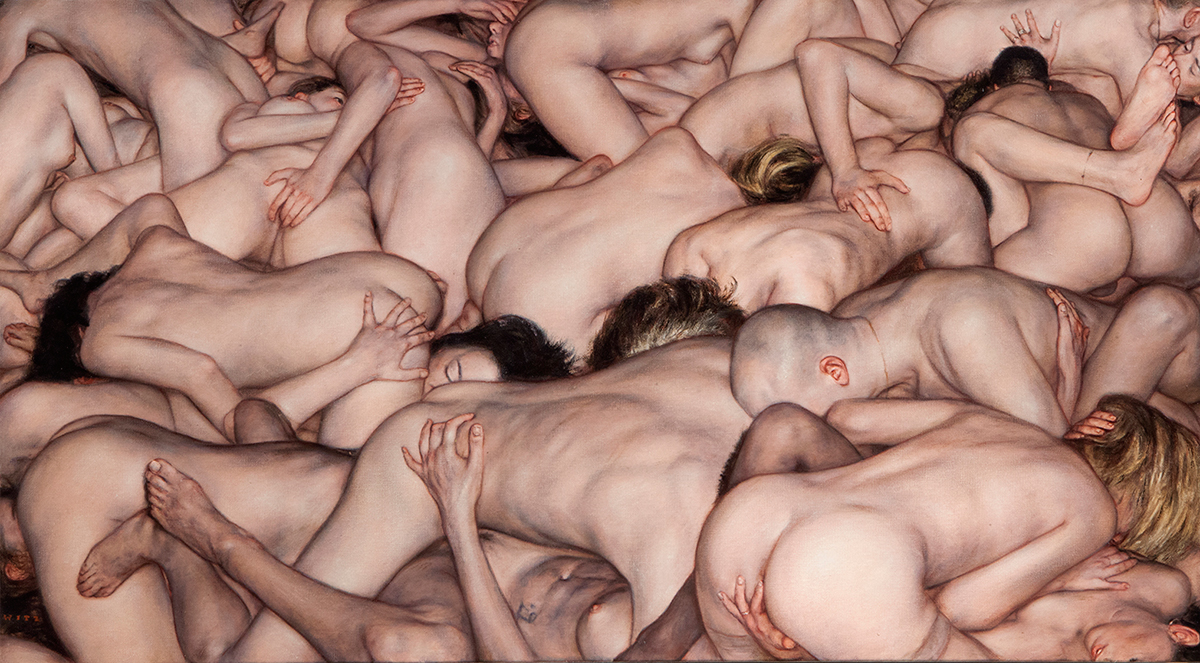
Small Orgy
Finally, what are you working on right now?
In the studio, I’m working on some big rave canvases, based on some pretty insane photos I’ve taken. And I’m about to embark upon some major street art installations.
The working title for the hardcore series is, YAWP!— after that Walt Whitman quote, “I sound my barbaric yawp over the rooftops of the world.” For the rave paintings I’m using, WOMP! which is a similar type evocation, this time for that primal body slamming bass sound at those concerts.
Originally featured on The Creator’s Project




